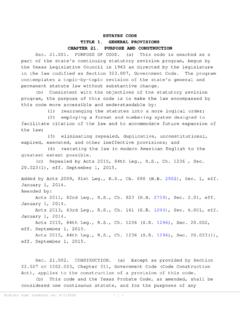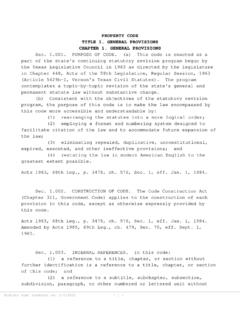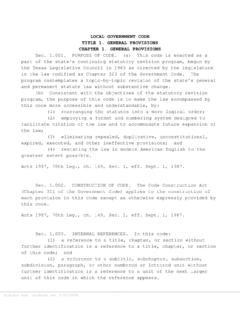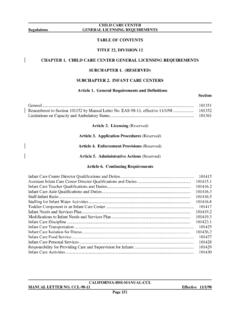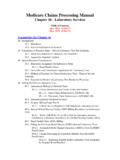Transcription of TITLE 26 -- INTERNAL REVENUE CHAPTER I -- INTERNAL …
1 TITLE 26 -- INTERNAL REVENUE CHAPTER I -- INTERNAL REVENUE SERVICE, DEPARTMENT OF THE TREASURY SUBCHAPTER A -- INCOME TAX PART 1 -- INCOME TAXES NORMAL TAXES AND SURTAXES DEFERRED COMPENSATION, ETC. METHODS OF ACCOUNTING ADJUSTMENTS 26 CFR Outline of regulations under 482. This section contains major captions for through section Allocation of income and deductions among taxpayers. (a) In general . (1) Purpose and scope. (2) Authority to make allocations. (3) Taxpayer's use of section 482. (b) Arm's length standard. (1) In general . (2) Arm's length methods. (i) Methods. (ii) Selection of category of method applicable to transaction. (c) Best method rule. (1) In general . (2) Determining the best method.
2 (i) Comparability. (ii) Data and assumptions. (A) Completeness and accuracy of data. (B) Reliability of assumptions. (C) Sensitivity of results to deficiencies in data and assumptions. (iii) Confirmation of results by another method. (d) Comparability. (1) In general . (2) Standard of comparability. (3) Factors for determining comparability. (i) Functional analysis. (ii) Contractual terms. (A) In general . (B) Identifying contractual terms. (1) Written agreement. (2) No written agreement. (C) Examples. (iii) Risk. (A) In general . (B) Identification of party that bears risk. (C) Examples. (iv) Economic conditions. (v) Property or services. (4) Special circumstances.
3 (i) Market share strategy. (ii) Different geographic markets. (A) In general . (B) Example. (C) Location savings. (D) Example. (iii) Transactions ordinarily not accepted as comparables. (A) In general . (B) Examples. (e) Arm's length range. (1) In general . (2) Determination of arm's length range. (i) Single method. (ii) Selection of comparables. (iii) Comparables included in arm's length range. (A) In general . (B) Adjustment of range to increase reliability. (C) Interquartile range. (3) Adjustment if taxpayer's results are outside arm's length range. (4) Arm's length range not prerequisite to allocation. (5) Examples. (f) Scope of review. (1) In general . (i) Intent to evade or avoid tax not a prerequisite.
4 (ii) Realization of income not a prerequisite. (A) In general . (B) Example. (iii) Nonrecognition provisions may not bar allocation. (A) In general . (B) Example. (iv) Consolidated returns. (2) Rules relating to determination of true taxable income. (i) Aggregation of transactions. (A) In general . (B) Examples. (ii) Allocation based on taxpayer's actual transactions. (A) In general . (B) Example. (iii) Multiple year data. (A) In general . (B) Circumstances warranting consideration of multiple year data. (C) Comparable effect over comparable period. (D) Applications of methods using multiple year averages. (E) Examples. (iv) Product lines and statistical techniques. (v) Allocations apply to results, not methods.
5 (A) In general . (B) Example. (g) Collateral adjustments with respect to allocations under section 482. (1) In general . (2) Correlative allocations. (i) In general . (ii) Manner of carrying out correlative allocation. (iii) Events triggering correlative allocation. (iv) Examples. (3) Adjustments to conform accounts to reflect section 482 allocations. (i) In general . (ii) Example. (4) Setoffs. (i) In general . (ii) Requirements. (iii) Examples. (h) Special rules. (1) Small taxpayer safe harbor [Reserved]. (2) Effect of foreign legal restrictions. (i) In general . (ii) Applicable legal restrictions. (iii) Requirement for electing the deferred income method of accounting. (iv) Deferred income method of accounting.
6 (v) Examples. (3) Coordination with section 936. (i) Cost sharing under section 936. (ii) Use of terms. (i) Definitions. (j) Effective dates. section Determination of taxable income in specific situations. (a) Loans or advances. (1) Interest on bona fide indebtedness. (i) In general . (ii) Application of paragraph (a) of this section . (A) Interest on bona fide indebtedness. (B) Alleged indebtedness. (iii) Period for which interest shall be charged. (A) general rule. (B) Exception for certain intercompany transactions in the ordinary course of business. (C) Exception for trade or business of debtor member located outside the United States. (D) Exception for regular trade practice of creditor member or others in creditor's industry.
7 (E) Exception for property purchased for resale in a foreign country. (1) general rule. (2) Interest-free period. (3) Average collection period. (4) Illustration. (iv) Payment; book entries. (2) Arm's length interest rate. (i) In general . (ii) Funds obtained at situs of borrower. (iii) Safe haven interest rates for certain loans and advances made after May 8, 1986. (A) Applicability. (1) general rule. (2) Grandfather rule for existing loans. (B) Safe haven interest rate based on applicable Federal rate. (C) Applicable Federal rate. (D) Lender in business of making loans. (E) Foreign currency loans. (3) Coordination with interest adjustments required under certain other INTERNAL REVENUE Code sections.
8 (4) Examples. (b) Performance of services for another. (1) general rule. (2) Benefit test. (3) Arm's length charge. (4) Costs or deductions to be taken into account. (5) Costs and deductions not to be taken into account. (6) Methods. (7) Certain services. (8) Services rendered in connection with the transfer of property. (c) Use of tangible property. (1) general rule. (2) Arm's length charge. (i) In general . (ii) Safe haven rental charge. (iii) Subleases. (d) Transfer of property. section Methods to determine taxable income in connection with a transfer of tangible property. (a) In general . (b) Comparable uncontrolled price method. (1) In general . (2) Comparability and reliability considerations.
9 (i) In general . (ii) Comparability. (A) In general . (B) Adjustments for differences between controlled and uncontrolled transactions. (iii) Data and assumptions. (3) Arm's length range. (4) Examples. (5) Indirect evidence of comparable uncontrolled transactions. (i) In general . (ii) Limitations. (iii) Examples. (c) Resale price method. (1) In general . (2) Determination of arm's length price. (i) In general . (ii) Applicable resale price. (iii) Appropriate gross profit. (iv) Arm's length range. (3) Comparability and reliability considerations. (i) In general . (ii) Comparability. (A) Functional comparability. (B) Other comparability factors. (C) Adjustments for differences between controlled and uncontrolled transactions.
10 (D) Sales agent. (iii) Data and assumptions. (A) In general . (B) Consistency in accounting. (4) Examples. (d) Cost plus method. (1) In general . (2) Determination of arm's length price. (i) In general . (ii) Appropriate gross profit. (iii) Arm's length range. (3) Comparability and reliability considerations. (i) In general . (ii) Comparability. (A) Functional comparability. (B) Other comparability factors. (C) Adjustments for differences between controlled and uncontrolled transactions. (D) Purchasing agent. (iii) Data and assumptions. (A) In general . (B) Consistency in accounting. (4) Examples. (e) Unspecified methods. (1) In general . (2) Example. (f) Coordination with intangible property rules.











